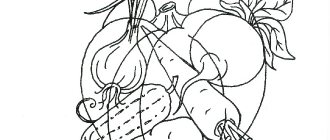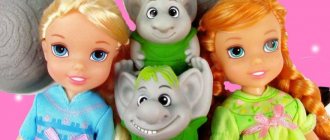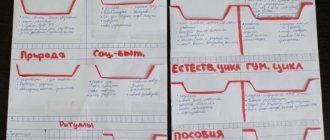Imagination is an extremely important mental process, but insufficient attention is usually paid to its development in preparation for school. Finding a non-standard solution to a problem, composing a story, writing an essay, doing creative work or coming up with an interesting research project - all this is impossible without a fairly good imagination. You can develop the imagination of preschool children with the help of various exercises and games, which will be discussed in this article.
On the characteristics of imagination in preschool children
In children, as in adults, experts distinguish the following types of imagination:
- Recreating. This type of imagination is inextricably linked with memory and imaginative thinking. With its help, a person can imagine what he heard or read about in a book.
- Creative imagination is the creation of new images by modifying already familiar ones (based on acquired experience).
- As a result of uncontrolled imagination, a person develops ideas that are not associated with any logic.
A person with a well-developed imagination has extraordinary creative thinking, which allows him to cope with various tasks more easily than others. Therefore, it is very important to encourage the child’s imagination and original solutions.
At preschool age, the imagination is most developed, because it is still difficult for children to act according to given rules. Imagination, like other mental processes, actively develops through play. While playing, children come up with new stories and use substitute objects (that is, a piece of paper becomes a movie ticket or a TV remote control becomes a mobile phone). Fantasy develops more actively if the child’s life is full of various events and vivid emotions, because new ideas are created on the basis of existing experience. It is also important to note that children often literally live in their own imaginary world and may confuse fantasy and reality. You need to carefully monitor the baby’s behavior and promptly introduce him to the real picture of the world in cases where this is necessary (for example, that you should not run out onto the road or stick your fingers into a socket).
Developing speech
Naturally, any person’s speech begins to develop from an early age, when children become familiar with their surroundings. However, it is still possible to help them. The main thing is to do it correctly so as not to harm the child.
There are three generally accepted ways of developing speech: visual, practical and verbal. In preschool organizations, a visual method is most often used, which consists in the teacher himself telling children about the world around them.
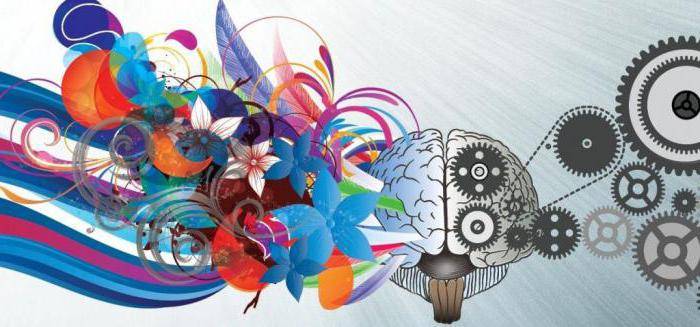
So, there is a direct version of this method, which involves visiting excursions or simply pointing at one or another object and pronouncing its name. Another option is indirect, which develops speech by describing certain images or toys. Thus, the skills of coherent speech are improved, and the vocabulary of children is consolidated.
Games and exercises for developing imagination in preschoolers
- “What would happen if...” This word game perfectly develops the imagination of preschoolers. Ask your child what would happen if, for example, cars flew or adults became small and children became big, and so on. The topic can be absolutely anything, and the questions themselves can be funny and absurd - this will only further motivate the child to think creatively.
- "Tall tales." This exercise is similar to the previous game. But instead of asking questions, the adult voices the beginning of the story, and the child must continue it so that something unprecedented turns out. As a visual support in this game, you can use various plot pictures, illustrations, newspaper and magazine clippings, as well as drawings by the child himself. Telling stories is an extremely powerful way to develop your creative imagination.
- "Magic box" Children love dress up games. Place old clothes, masks, hats and other accessories in a box. Together with your baby, you can sew a real fancy dress costume from various materials. The child will be happy to put on a costume performance at home or have a fashion show.
Participate in your child’s games and come up with new stories together. This will not only help develop your baby’s imagination, but will also strengthen your relationship.
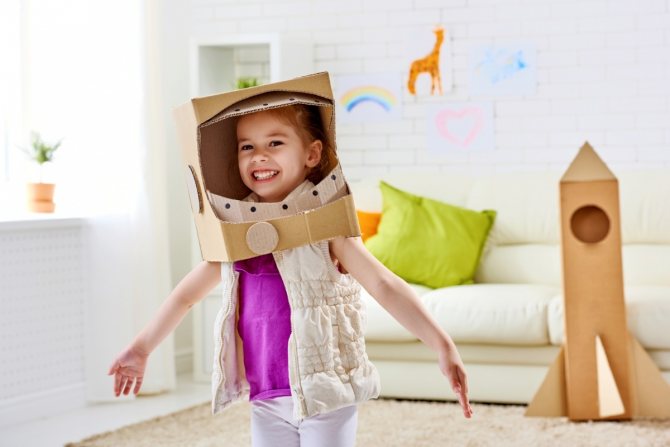
- "What does a cloud look like?" While walking with your baby, look around: look at the clouds, tree branches, shadows, puddles under your feet. Think about what they look like.
- “What can this thing be used for?” Invite your child to come up with as many ways as possible to use some simple objects (for example, a pencil, a piece of paper, a pebble, a sock, etc.). In a child's imagination, an ordinary glass can become a house for a bug, a signal light for a police car, or a musical instrument.
- Writing fairy tales. Together with the baby, compose a fairy tale on a topic that is close to the child. The presence in it of familiar plots and the child’s favorite characters are important factors necessary to captivate the child with the game.
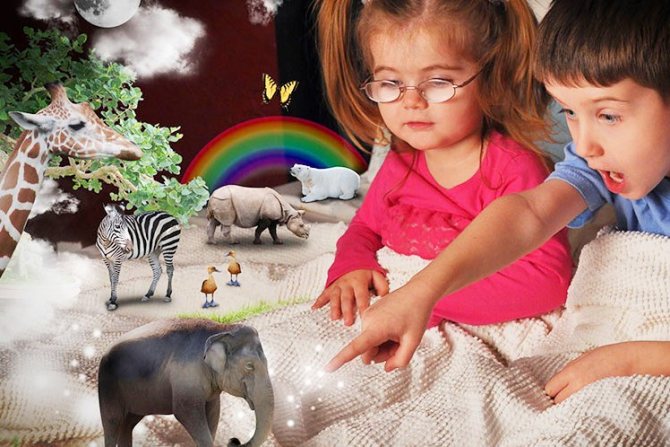
- “Complete the figure.” Draw several geometric shapes on a piece of paper and ask your little one to add details to them so that each shape turns into an object.
- Blotography. A similar exercise can be performed using paints. Let your child put a colored blot on a piece of paper and then draw it into something meaningful.
- "Non-existent animal." This is not just a game, but a projective drawing test, which in the hands of a specialist can tell a lot about a child’s personality. At home, the task that underlies this technique will serve as an excellent way to develop the imagination of preschool children. Ask your child to come up with and draw an animal that does not exist (neither in life, nor in fairy tales, nor in cartoons) and give it a non-existent name. After the drawing is ready, discuss his work with your child: find out what kind of character the invented character has, what he likes to do and what he doesn’t, whether he has friends or enemies.
- Creative activities: drawing, modeling, appliqué.
Through creativity, children express their fantasies, feelings, thoughts and experiences. But in this case we are talking specifically about free creative activity, when the child decides for himself what he wants to depict. If we talk about coloring and making crafts based on patterns, then these activities only contribute to the development of fine motor skills and the ability to follow instructions, but not imagination.
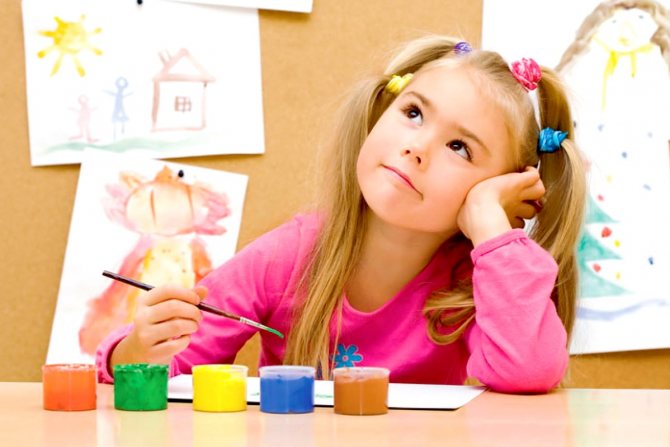
- Construction. Every time your baby builds something new without using a pattern or instructions, he is using his imagination and learning to think creatively.
- Free role-playing play is the leading activity of preschoolers, therefore it is in it that all mental processes develop most actively and naturally. When playing with peers, children are in an imaginary situation with their own rules and distribution of roles.
Toys
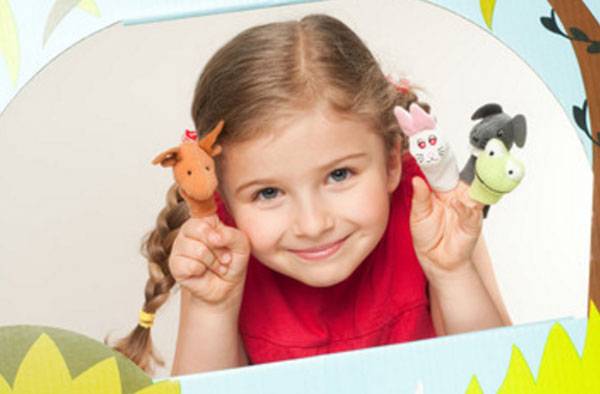
Let's look at what kinds of toys there are that develop the imagination.
Lotto with pictures. When taking out a card with a certain image, invite your child to accompany the picture with an interesting, short story. When mom draws the next card, she must also describe the image with a short story. When your child masters this game, you can make it slightly more difficult. Now, when pulling out cards, you need to not only describe the image with a story, but also connect your story and the child’s with each other. Accordingly, the baby will have to continue the mother’s story, pulling out subsequent cards. Puppet show. Both finger toys and those that fit on the hand are suitable
It is important that the child can come up with a story using certain characters. If it’s difficult for a child to come up with a fairy tale right away, then for the first time you can do it instead. A construction set is a great toy that allows you to develop imagination and imagination.
To use this toy effectively, you should not use instructions when building it. There is a wide variety of designers. They come in plastic, metal, and wood. Let the child create using his imagination. Cubes. They are also great for developing imagination. Let your child come up with his own designs. If it’s still difficult for the little one, help. Children's kitchen, household appliances, doctor's kits - all this allows you to create role-playing games, developing the baby's imagination.
conclusions
The modern world requires a person to be able to find non-standard solutions to problems. Already in elementary school, the child is faced with tasks that require a creative approach to successfully complete. Preschool age is considered the most favorable for the development of imagination. To do this, there are many games and exercises in which kids need to independently come up with something new and unusual. And don’t forget to set an example for your child, because children copy the behavior of adults: play and fantasize with your baby.
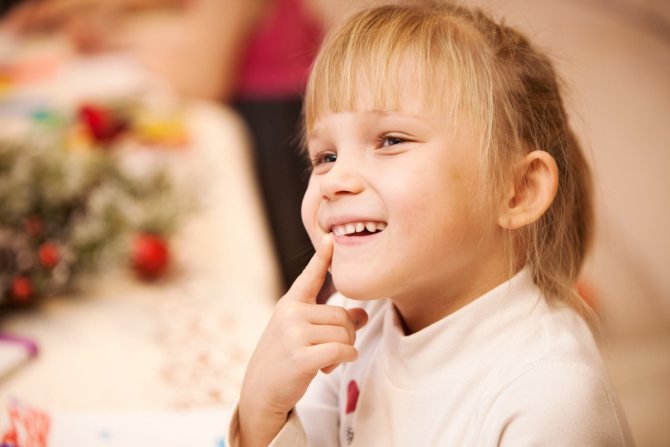
Varieties of Imagination
There are many types of this mental process. Let's briefly consider the main ones.
Active. Thanks to him, we have the ability to consciously evoke the necessary image. In turn, it is divided into:
- Creative - helps to create new images, which are later embodied in a painting, architectural work, music, clothing, etc. Without at least a remote idea of the future result of his work, a person will not start working. This type is also called productive, since the image created by our brain is later brought to life in the form of a painting, sculpture, song, clothing and much more.
- Recreating - allows you to again and again present a visual image of those things that we have already seen. This type is very important, since the information accumulated by it is the basis from which ideas for creativity are drawn.
Passive. It generates images and ideas that will not be brought to life by humans in the near future. May be conscious or unconscious.
- A dream is the ability of the human brain to generate images of the distant future, to plan things that, in general, can be accomplished, but not in the near future. Dreams manifest themselves consciously.
- Dreams. The main feature of this type of imagination is that the implementation of images created by the brain is impossible and unrealistic. They appear consciously.
- Hallucinations are the unconscious generation by the human brain of images that are unreal and non-existent. They appear in the event of a malfunction of the brain (for example, as a result of taking certain medications or mental illness). Their impact is so strong that a person has absolutely no doubt about their unreality.
- We see dreams at a time when our body is resting. They appear unconsciously.
Types and functions of a child’s imagination
In psychology, a distinction is made between cognitive and emotional childhood imagination. The emotional is aimed at regulating the feelings experienced and the formation of the personal Self, and the cognitive contributes to the understanding of the surrounding reality. Both types are involved involuntarily in early preschool age. Only by the age of 6 does a child learn to deliberately come up with a plan in order to consistently implement it.
Involuntary
Adults are often amazed at children's free imaginations and are puzzled why the child cannot or does not want to fantasize on a given topic. But before the age of 5, the reasons are exclusively objective - the youngest preschooler does not yet know how to control his imagination.
Involuntary imagination is characterized by the fact that the idea arises spontaneously and is associated with objects, stories or incidents that surprised and excited the child. It could be a fairy tale story or a cartoon character, a bright toy or an unusual event.
Imagination seems to lead the child’s thoughts along with it, giving him ideas for creating an image. Its main feature in early preschool age is the lack of control over the process.
free
Elements of arbitrariness appear upon reaching the age of five. Voluntary imagination is also called active imagination. Often the trigger is the task at hand: for example, performing the actions of your hero in role-playing games. To portray a cowboy, an astronaut or Malvina, the imagination has to work in full force - after all, the role must be depicted as accurately as possible.
You should not wait for a preschooler to awaken the ability to purposefully use his imagination. The adult’s task is to encourage the child to come up with images.
You can remember and discuss a children's work together, pay attention to individual characters, consider options for creating an image
Within the framework of arbitrary imagination, there are 3 types:
- Recreating - the task is to imagine the child followed by a description of an object or item that he did not see. Example: a non-existent animal, a resident of Mars or the Moon.
- Creative imagination - a preschooler creates new images based on personal perception, moving away from known patterns and pushing boundaries.
- Dreams - from a child’s fantasies of what he will receive for his birthday to ideas of what he will become when he grows up.
Cognitive function
Imagination performs two important functions. Cognitive ensures the elimination of “blind spots”. A child’s mind has already formed a certain idea of the world around him, but many gaps have not yet been filled. The ability to operate with images “fills” these spots and helps to obtain yet unknown impressions.
In addition, imagination helps explain the meaning of a person’s actions if, due to his age, the baby does not understand why someone is crying, laughing or doing something incomprehensible.
The older the preschooler, the more he takes into account natural patterns in his fantasies.
It is important for him to come up with images in which, along with fantastic qualities, there would be real characteristics
Affective function
The affective function of the preschooler’s imagination is aimed at upholding and protecting one’s own self. The relationship between anxiety and imagination helps to avoid injury.
Emotional fixation on certain experiences unconsciously pushes the child to simulate a situation that is significant to him in one of the ways known to him:
1. An impact or situation that has a negative impact on the psyche is repeatedly played out. Numerous repetitions help to distance yourself from the event itself and turn from a participant into an observer.
2. If necessary, the child creates situations in which he feels like a hero. He puts himself in the shoes of numerous superheroes and saves worlds with a sense of agility, courage and power. Frequent repetitions of situations with victories and successes help a preschooler increase self-esteem.
How to develop imagination as an adult
Plunging headlong into the routine of everyday worries, an adult consciously limits his vision of the world to the narrow framework of the events and images he needs. This does not mean that his ability to imagine is lost, but it becomes more and more difficult for him to realize it every year.
Exercises for developing imagination in adults are created taking into account the need to abandon the baggage of old patterns that force one to think in stereotypes. The consciousness of an adult is designed in such a way that when trying to think outside the box, a whole chain of defense mechanisms is activated in his head. For this reason, from the first days you should not try to devote more than 10 minutes at a time to exercises to develop your imagination.
It is advisable to start with simple observation in conditions close to everyday ones - for example, on the way home from work. Even a path traveled many times can be fraught with many surprises that will both amuse and shock you if you look at them more closely. An amusingly composed advertisement on the wall, the burning windows of a high-rise building forming alphabetic or numerical signs - once you open your mind to the unusual, your imagination will work with redoubled force.



